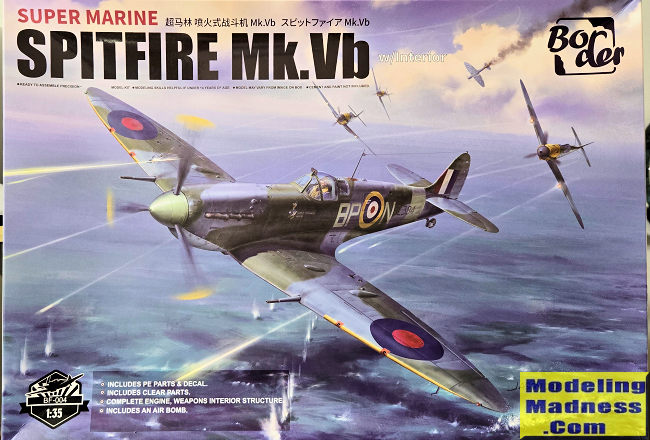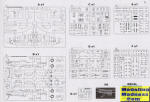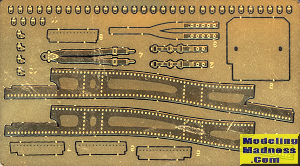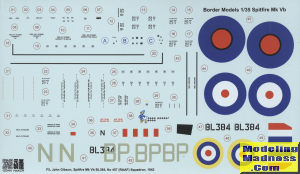
Border 1/35 Spitfire Vb
| KIT #: | BF-004 |
| PRICE: | $41.61 delivered from China |
| DECALS: | One option |
| REVIEWER: | Scott Van Aken |
| NOTES: | New tool kit |

| HISTORY |
Late in 1940, the RAF predicted that the advent of the pressurised Junkers Ju 86P bomber series over Britain would be the start of a new sustained high altitude bombing offensive by the Luftwaffe, in which case development was put in hand for a pressurised version of the Spitfire, with a new version of the Merlin (the Mk VI). It would take some time to develop the new fighter and an emergency stop-gap measure was needed as soon as possible: this was the Mk V.
The basic Mk V was a Mk I with the Merlin 45 series engine. This engine delivered 1,440 hp (1,074 kW) at take-off, and incorporated a new single-speed single-stage supercharger design. Improvements to the carburettor also allowed the Spitfire to use zero gravity manoeuvres without any problems with fuel flow. Several Mk I and Mk II airframes were converted to Mk V standard by Supermarine and started equipping fighter units from early 1941. The majority of the Mk Vs were built at Castle Bromwich.
Three versions of the Mk V were produced, with several sub-series
| THE KIT |
 Border
Models has been introducing a line of 1/35 WWII fighters, with this Spitfire
being the latest. I'm not sure why they picked 1/35 scale unless they wished for
the kits to be compatible with armor kits, of which a lot are produced in this
scale. I have built one 1/35 airplane and that was a resin Bf-109 many years
ago. When placed next to a 1/32 109, it is about the only time you will notice
that there is a difference in size. Probably the only down side is that there
are few dedicated 1/35 aftermarket decals and accessories for these kits.
Border
Models has been introducing a line of 1/35 WWII fighters, with this Spitfire
being the latest. I'm not sure why they picked 1/35 scale unless they wished for
the kits to be compatible with armor kits, of which a lot are produced in this
scale. I have built one 1/35 airplane and that was a resin Bf-109 many years
ago. When placed next to a 1/32 109, it is about the only time you will notice
that there is a difference in size. Probably the only down side is that there
are few dedicated 1/35 aftermarket decals and accessories for these kits.
This one reminds me a bit of early Trumpeter kits and that is because all of
the flight control surfaces have a similar attachment design. In this case, all
the parts are in plastic and not in metal and photo etch. The kit is designed to
have a lot of open panels for the guns and the engine. In fact, you are provided
a plethora of small fastener receptacles for the various engine panels.
Hopefully, the panels are a good fit as there are those who don't like having
everything opened up. Even when building panels closed, you still have to use
the engine block and mounts so that you have a place to attach the prop and
exhaust. 
A nicely done interior is provided with the proper open architecture for the floor. Some of the p.e. is used here with the big pieces for the seat harness and armor plate. As mentioned, you are provided with full guns as well as the ammunition feed chutes and bins. Again, if you want to leave the panels closed, you can eliminate the ammo bits, but still need to keep the guns. Other items are a full radio compartment with a separate access panel. The kit's cockpit entry door is also separate. Note that this door has a crowbar attached to it, which may or may not be prototypical for an early Mk.V.
The clear bits are all separate, though I'm not sure if the canopy will properly fit in the open position. There is a separate armored windscreen piece to fit over the standard windscreen. Speaking of windscreens, this kit only comes with an early type as used on previous variants of the Spitfire. Later MkV aircraft had a windscreen with an internal armored section that also had a piece in the very top of the windscreen that was clear. This can be spotted by an additional fore/aft frame near the top of the windscreen. The kit also only includes the deHavilland prop and not a Rotol version as used in later aircraft. This will severely limit your possible aftermarket marking options. I would bet that Border will, in the future, release a later Mk.V with these features.
Landing gear are well done with the main wheels coming with separate hubs and
tires. This will surely make painting easier. The kit provides the proper five
spoke wheels. The inner wheel wells are provided as photo etch parts, so some
skill in curving these pieces is required. Annealing these parts would seem to
be mandatory to make them easier to bend. A bomb for the centerline is also
provided with the holes in the lower wing already pre-drilled. I should note
that the box art shows a long wire antenna, however, by September 1940,
frontline RAF units were
 equipped
with VHF radios that did not use this feature, though they kept the same radio
mast. Aircraft with the older radios were quickly retrofit with the newer sets
by maintenance units. The old long wire mounting units were often kept in place.
equipped
with VHF radios that did not use this feature, though they kept the same radio
mast. Aircraft with the older radios were quickly retrofit with the newer sets
by maintenance units. The old long wire mounting units were often kept in place.
Instructions are well done and provide MiG paint references along with BS references. The lone marking option was with 457 squadron in 1942 in the then standard European fighter scheme. The decals are nicely printed, but the roundel colors seem too bright. The upper wing roundels in particular have a black circle surrounding the red center.
| CONCLUSIONS |
So do we need another large scale Spitfire? Not really, but that has never stopped kit makers who are looking for a kit they know will sell fairly well, and companies are in business to make money. This one appears to be well done and will appeal to those who like all the compartments opened up in their kits. Those who don't care for that sort of thing can snag a kit from some other company that doesn't offer those options. Regardless, this one should build into a nice model and Euro Decals has already produced a sheet for it if you are looking for different markings.
| REFERENCES |
https://en.wikipedia.org/wiki/Supermarine_Spitfire_(early_Merlin-powered_variants)
July 2024
Copyright ModelingMadness.com. All rights reserved. No reproduction in part or in whole without express permission from the editor.
If you would like your product reviewed fairly and fairly quickly, please contact the editor or see other details in the Note to Contributors.